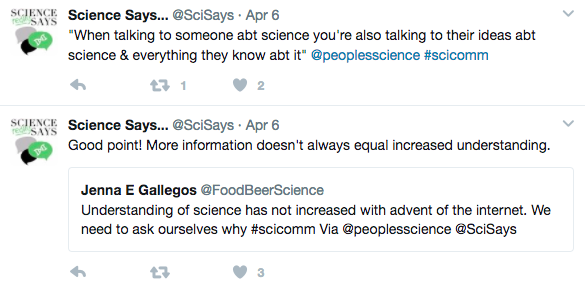
Next Level Science Communication: Humanize, Normalize, Illuminate
Typically, science communication seminars or workshops spend a lot of time convincing participants why science communication is important. I am beyond this point. And, furthermore, I think we as a scientific community are beyond this point. We know the importance of science communication for science literacy, scientific funding, and science policy. Scientists will either get on board or be left behind.
How do we move to the next level? I think small, focused workshops are one potential avenue. Recently, I attended a science communication workshop at the University of California, Davis. The workshop was hosted by two groups: The People's Science and Science Says. Stephanie Fine Sasse, the Executive Director of The People's Science, led the event.
Stephanie and the workshop organizers executed a great workshop on several dimensions. First, the workshop was limited to 30 people and the room was small, which made the time more intimate and focused. Second, organizers asked participants to prepare a lay summary of a recent paper prior to the workshop. This facilitated discussions about our summaries during the workshop. Third, the workshop was three hours in length, providing enough time to dive into specific issues. Lastly, Stephanie did a great job of discussing specific tactics scientists can implement moving forward. She illustrated her points through a number of good examples and participant exercises.

Moving beyond the workshop setup, what did participants actually learn? To begin the workshop, Stephanie presented a brief history of science literacy and science communication. This set the stage for current challenges science communicators face. She argued that now scientists have to reach out to the public and science itself has to be more connected to society. She also pointed to solutions which work to engage the public in science, like citizen science projects. There were three major takeaways I took from Stephanie's presentation.
1) We (scientists) need to humanize scientific research.
Here, Stephanie stressed the importance of including the scientist, and their story, when communicating science. This builds trust between the science and the public. It is important for people to understand scientists are people too, not just some expert in an ivory tower. Further, telling a scientist's story creates a more interesting story for the public.

2) We need to normalize science communication.
A lot of scientists worry about participating in science communication. They fear that colleagues may perceive them in a negative light. It will be important to create a culture within science where science communication is not only typical, but also incentivized. Tangible incentives for science communication would allow researchers more time to communicate their science. For instance, science communication could be part of a broader impacts statement in a grant or during the tenure process.

3) We need to illuminate the scientific process.
Yes, it is important to explain the latest and coolest scientific findings to the public. However, it is equally important – if not more so – to discuss the scientific process itself. Again, the storytelling of science is important. Describing the process that led to the discovery has at least two benefits. First, describing the process helps people understand how science works. For instance, describing the way a drug is brought into development would hopefully make people feel more at ease about the process. In addition, learning about the process of science enables people to think critically themselves.
What practical, tangible steps can scientists take? First, scientists must carve out time for science communication. As we all know too well, if you do not plan something in your schedule, you will never get to it. Once an individual wants to engage in science communication, there are a number of questions one should ask themselves: What audience do you want to reach? This will determine the appropriate medium for communicating science. Are there groups that you can collaborate with to communicate your science? A number of universities now have groups focused on science communication, either informally through clubs or through a media communications department. After answering these questions, the next step would be to develop the material for presentation.

Moving forward it will be important to offer small and focused workshops. A small group enables a richer dialogue between participants and instructors. Focused workshops are important to get into the nitty gritty details of how to actually engage with science communication. Lastly, a small and focused workshop allows participants to test their ideas on a willing audience. The workshop can serve as a laboratory for experiments with new analogies, active learning exercises, or pieces of writing.You can find more information here: The People's Science and Science Says.
Easton White is a PhD student at the University of California in Davis. For more content from the UC Davis science communication group "Science Says", follow us on twitter @SciSays.

Comments